 |
| Kamran Shirdel at the exhibition. Photo (c) Houshang Golmakani |
The Curious and the Downcast: An Interview with Kamran Shirdel
By Houshang Golmakani
An interview with the distinguished Iranian filmmaker, photographer, and writer about his latest exhibition of films and photographs taken during the days of the Iranian Revolution. I commissioned this for a winter 2019 issue of Underline magazine but by the time this was translated and edited, the Underline project was abruptly folded. I publish it here for the first time. — EK
As we approach the 40th anniversary of the revolution that saw the monarch of Iran overthrown and replaced with an Islamic republic, renowned documentary filmmaker and photographer Kamran Shirdel is now exhibiting his photographs and raw, unedited footage of the historical event for the first time at a gallery in Tehran. Born in 1939, Shirdel originally studied architecture at the University of Rome before going on to study film at the Centro Sperimentale di Cinematografia. Upon his return to Iran in 1964, he produced a number of documentaries on Iranian social issues in the space of just a few years, the most famous of which include Women's Prison, Women's Quarter, Tehran Is the Capital of Iran, and his satirical masterpiece The Night It Rained. Due to their controversial subjects, all of these early documentaries were banned at the time of their release and Shirdel had several encounters with the Shah's secret police force SAVAK as a result. With the exception of his first and only feature-length film, The Morning of the Fourth Day (1972), Shirdel was forced to pursue industrial documentary filmmaking in the years that followed. 1978 saw a rise in strikes and social unrest that fuelled the fires of an impending revolution: the event that Shirdel had been waiting for ever since his return to Iran. Armed with a video camera and a camera, Shirdel took to the streets of Tehran, tirelessly documenting every development throughout the course of the revolution.
40 years later, and for the first time since they were taken, Shirdel's photographs and footage from those days are now being exhibited at the Nabshi Centre in Tehran from 30 November 2018 to 25 January 2019. Shirdel, who was 39 years old at the time of the revolution, will turn 80 later this year. Despite his age and a spinal condition that requires him to use a walking stick, Shirdel still attends the exhibition almost every day in order to see the effects of his work first-hand. The exhibition itself is relatively large, covering two floors, with mostly large-scale photographs displayed on the walls and 40-year-old, antique television sets showing 8mm footage on repeat. Unfortunately, Shirdel's 16mm footage was confiscated in the days following the revolution and no trace of them has been seen since then.




.jpg)



.jpg)













